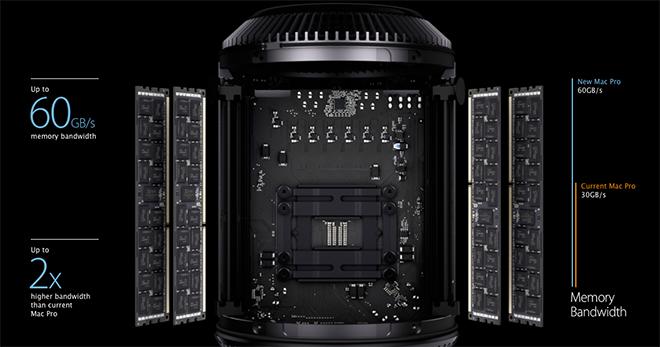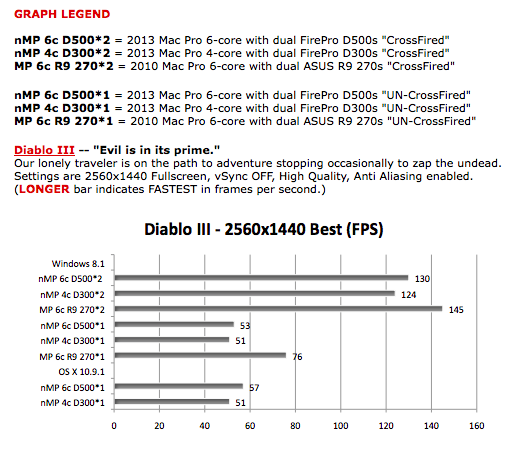Apple's newly-redesigned Mac Pro ships standard with dual GPUs configured via hardware to support AMD's CrossFire GPU-pairing technology, but only when running Microsoft Windows.

Enabling CrossFire under Windows between the new Mac Pro's two AMD FirePro GPUs can provide a significant speed boost in frame rates for specific graphics-intensive applications such as games, as noted in a report by BareFeats.com.

AMD's CrossFire technology links the two GPUs to make them appear to be one fast GPU, conceptually similar to grouping drives in a RAID configuration.
Outside of video games, AMD claims an "up to double-digit percentage performance gain" in specific apps including Autodesk's Maya when linking two FirePro GPUs via CrossFire.
The potential for CrossFire on Apple's Macs
Apple's OS X doesn't support currently CrossFire, however, as the technology requires firmware and driver support that AMD currently only supplies for Windows XP, Vista or 7 and Linux.
AMD acquired CrossFire as part of ATI's graphics technology portfolio in 2006. It's never made it to the Mac largely because Macs haven't played much of a role among gamers willing to pay hundreds of dollars for multiple video cards. And while Macs have begun to play a significant role in video editing, the higher end 3D applications targeted by CrossFire are principally used on Windows PCs or Linux workstations designed to accommodate multiple GPUs.
On Apple's end, support for AMD's CrossFire was restricted not only by the limited niche market for dual video card Macs, but also because CrossFire (like NVIDIA's competing SLI) is proprietary and therefore restricted to working only across specific models of each vendors' GPUs. Apple has preferred the independence of being able to switch back and forth between the two GPU vendors.
The fact that all of Apple's Mac Pros (AI review) now ship standard with a narrow selection of dual AMD FirePro GPUs makes it plausible that Apple could invest in supporting CrossFire under future versions of OS X in order to squeeze more performance from the new machine's architecture under apps without requiring hardware-specific optimizations.
Without CrossFire, apps and games running on the Mac Pro must be custom written to take advantage of the two GPUs. According to AnandTech, Apple has configured the Mac Pro so that "by default, one GPU is setup for display duties while the other is used exclusively for GPU compute workloads."
The site noted that "it is up to the game developer to recognize and split rendering across both GPUs, which no one is doing at present," and that, "unfortunately firing up two instances of a 3D workload won't load balance across the two GPUs by default."
Apple's support for GPU-specific development
In December, Apple's own Final Cut Pro 10.1 update delivered custom support for using both of the new Mac Pro's dual GPUs to speed compute tasks, with the company specifically noting "optimized playback and rendering using dual GPUs in the new Mac Pro."
And of course, Apple's Grand Central Dispatch in OS X is designed to spread tasks across all available GPU and CPU cores available on a system, but only for apps that are written to package tasks in a way that the system can manage.
Over the past five years, Apple has been working to make use of GCD and Open CL to increasingly delegate more tasks to the GPU that would historically be run simply on the main CPU. With Mac sales increasing overall, and with the new Mac Pro standardizing upon a dual configuration of a specific family of GPUs, it's increasing likely that Apple will offer new and expanded support for tools to ease developers' use of the available hardware.
If Apple does add support for AMD's CrossFire (or a similar GPU-teaming technology) in an upcoming release of OS X, it will also make it more likely that that company will enhance its other Mac models to incorporate support for multiple GPUs, providing a more flexible, cost effective and energy efficient route to faster overall performance without relying entirely upon larger, faster Intel CPUs.
Apple's newest iOS devices already incorporate multiple GPU cores, which are used to support the computationally intensive task of pushing pixels to high density Retina Display screens.
The massive shift to mobile devices at the expense of conventional Windows PCs in recent years has accelerated developers' interest in OpenGL and OpenCL and driven development resources and efforts toward Apple's Cocoa development tools, benefitting Apple's desktop Mac platform in the process.